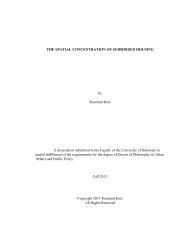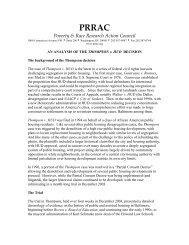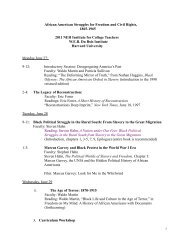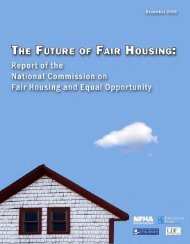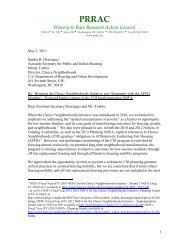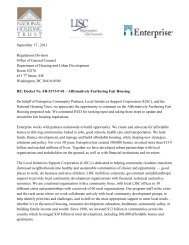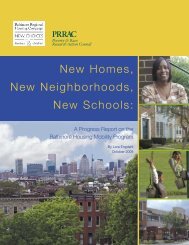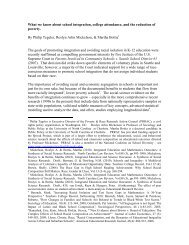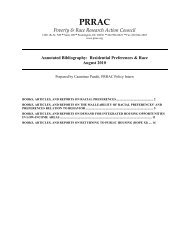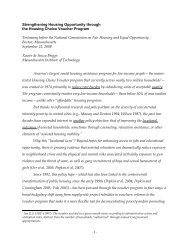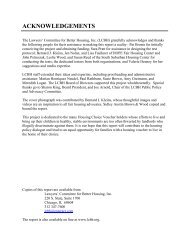Annotated Bibliography of Housing Mobility Research 2006-2010
Annotated Bibliography of Housing Mobility Research 2006-2010
Annotated Bibliography of Housing Mobility Research 2006-2010
Create successful ePaper yourself
Turn your PDF publications into a flip-book with our unique Google optimized e-Paper software.
Although MTO provides crucial leverage for estimating neighborhood effects on individuals, as<br />
proponents rightly claim, this study demonstrates the implications imposed by a stratified urban<br />
structure and how MTO simultaneously provides a new window on the social reproduction <strong>of</strong><br />
concentrated inequality.<br />
Sanbonmatsu, Lisa, Jeffrey R. Kling, Greg J. Duncan & Jeanne BrooksGunn, “Neighborhoods<br />
and Academic Achievement: Results from the Moving to Opportunity Experiment,” The<br />
Journal <strong>of</strong> Human Resources 41(4): 649 (<strong>2006</strong>)<br />
Abstract:<br />
Families originally living in public housing were assigned housing vouchers by lottery;<br />
encouraging moves to neighborhoods with lower poverty rates. Although we had hypothesized<br />
that reading and math test scores would be higher among children in families <strong>of</strong>fered vouchers<br />
(with larger effects among younger children), the results show no significant effects on test scores<br />
for any age group among more than 5,000 children aged six to 20 in 2002 who were assessed four<br />
to seven years after randomization. Program impacts on school environments were considerably<br />
smaller than impacts on neighborhoods, suggesting that achievementrelated benefits from<br />
improved neighborhood environments alone are small.<br />
Snell, Emily K., & Greg J. Duncan, “Child Characteristics and Successful Use <strong>of</strong> <strong>Housing</strong><br />
Vouchers: Estimates from the Moving to Opportunity Demonstration,” <strong>Housing</strong> Policy Debate<br />
17(4):72754 (<strong>2006</strong>)<br />
Abstract:<br />
Uses data collected from 2,938 households in the Moving to Opportunity demonstration program<br />
to estimate the influence <strong>of</strong> child characteristics on a household's probability <strong>of</strong> using a Section 8<br />
housing voucher to lease a residence in the private market, also called "takeup." Finds that basic<br />
child characteristics have little bearing on the takeup <strong>of</strong> housing vouchers. However, finds that<br />
child health, behavioral, and educational problems that affect the ability to go to school and the<br />
presence <strong>of</strong> lowbirthweight babies do influence takeup. Households with two or more child<br />
problems are 7 percentage points less likely to move than those who have none <strong>of</strong> these problems or<br />
only one. Argues that policymakers and program implementers need to find ways to help these<br />
families, otherwise programs will continue to suffer reduced takeup among this particularly needy<br />
population<br />
Sobel, Michael E., “What Do Randomized Studies <strong>of</strong> <strong>Housing</strong> <strong>Mobility</strong> Demonstrate”, Journal<br />
<strong>of</strong> the American Statistical Association 101(476): 1398–1407 (<strong>2006</strong>)<br />
Abstract:<br />
During the past 20 years, social scientists using observational studies have generated a large and<br />
inconclusive literature on neighborhood effects. Recent workers have argued that estimates <strong>of</strong><br />
neighborhood effects based on randomized studies <strong>of</strong> housing mobility, such as the “Moving to<br />
Opportunity” (MTO) demonstration, are more credible. These estimates are based on the implicit<br />
assumption <strong>of</strong> no interference between units; that is, a subject’s value on the response depends<br />
only on the treatment to which that subject is assigned, not on the treatment assignments <strong>of</strong> other<br />
subjects. For the MTO studies, this assumption is not reasonable. Although little work has been<br />
done on the definition and estimation <strong>of</strong> treatment effects when interference is present,<br />
interference is common in studies <strong>of</strong> neighborhood effects and in many other social settings (e.g.,<br />
schools and networks), and when data from such studies are analyzed under the “nointerference<br />
assumption,” very misleading inferences can result. Furthermore, the consequences <strong>of</strong> interference<br />
(e.g., spillovers) should <strong>of</strong>ten be <strong>of</strong> great substantive interest, even though little attention has been<br />
paid to this. Using the MTO demonstration as a concrete context, this article develops a<br />
framework for causal inference when interference is present and defines a number <strong>of</strong> causal<br />
estimands <strong>of</strong> interest. The properties <strong>of</strong> the usual estimators <strong>of</strong> treatment effects, which are<br />
unbiased and/or consistent in randomized studies without interference, are also characterized.<br />
18



